A Review on Lithium-Ion Battery Modeling from Mechanism-Based and Data-Driven Perspectives
Abstract
1. Introduction
2. A Comprehensive Review of Mechanism Models for LIBs
2.1. Mechanism Models for LIBs
2.1.1. Equivalent Circuit Model
2.1.2. Pseudo-Two-Dimensional (P2D) Model
- (1)
- The concentration distribution equation of lithium ions in the solid phase (along the r direction).
- (2)
- The concentration distribution equation of lithium ions in the liquid phase (along the x direction).
- (3)
- The electric potential distribution in the solid phase.
- (4)
- The electric potential distribution in the liquid phase
- (5)
- The BV equation.
- (6)
- The terminal voltage of the battery.
2.1.3. Cellular Automata (CA) Model
2.2. The Incorporation of Electrode Morphology in Mechanism Models
2.3. The Incorporation of Battery Aging in Long-Cycle Modeling of LIBs
2.3.1. Side Reactions Involved in the Growth of SEI Layer
2.3.2. Side Reactions of Lithium Deposition
2.3.3. The Consumption of Electrolytes and Additives
3. Data-Driven Modeling for LIBs
- (1)
- Data collection and preprocessing
- (2)
- Health indicator extraction and feature selection
- (3)
- Feature extraction for battery state estimation
3.1. Public Database for LIB Modeling
- (1)
- MIT dataset
- (2)
- NASA dataset
- (3)
- Center for Advanced Life Cycle Engineering (CALCE) dataset
- (4)
- Oxford Dataset
3.2. The Extraction of Health Indicators for LIBs
3.3. Feature Selection
3.4. Feature Extraction by ML Algorithms
3.5. The Software for Establishing and Running the Models
4. Challenges and Potential Directions for Future Research
4.1. Limitations of Mechanistic and Data-Driven Models
4.2. Future Prospects
5. Conclusions
Author Contributions
Funding
Data Availability Statement
Conflicts of Interest
Abbreviations
| cs | Lithium-Ion Concentration in Solid Phase | mol·m−3 |
| ce | Lithium-ion concentration in liquid phase | mol·m−3 |
| r | Radial direction | m |
| x | Thickness direction | m |
| t | Time | s |
| Ds | Solid diffusion coefficient | m2·s−1 |
| De | Liquid diffusion coefficient | m2·s−1 |
| t0+ | Transfer number | / |
| JLi | Solid–liquid interfacial flux | mol·m−2·s−1 |
| εe | Porosity | / |
| F | Faraday constant | C·mol−1 |
| φs | Electric potential in solid phase | V |
| φs | Electric potential in liquid phase | V |
| E0 | Equilibrium potential | V |
| η | Reaction overpotential | V |
| σ | Conductivity of solid phase | S·m−1 |
| κeff | Effective liquid-phase conductivity | S·m−1 |
| κdeff | Effective diffusion conductivity | A·m−1 |
| f | Ionic activity coefficient | / |
| T | Temperature | K |
| R | Gas constant | J·mol−1·K−1 |
| cs,max | Maximum particle concentration | mol·m−3 |
| cs,surf | Particle surface concentration | mol·m−3 |
| cs | Lithium-ion concentration in solid phase | mol·m−3 |
| ce | Lithium-ion concentration in liquid phase | mol·m−3 |
References
- Omar, N.; Monem, M.A.; Firouz, Y.; Salminen, J.; Smekens, J.; Hegazy, O.; Gaulous, H.; Mulder, G.; Van den Bossche, P.; Coosemans, T.; et al. Lithium iron phosphate based battery—Assessment of the aging parameters and development of cycle life model. Appl. Energy 2014, 113, 1575–1585. [Google Scholar] [CrossRef]
- Hu, X.; Wang, Z.; Zeng, S.; Guo, J.; Qin, T. Remaining capacity estimation of lithium-ion batteries based on the constant voltage charging profile. PLoS ONE 2018, 13, e0200169. [Google Scholar] [CrossRef]
- Wang, Y.; Liu, B.; Li, Q.; Cartmell, S.; Ferrara, S.; Deng, Z.D.; Xiao, J. Lithium and lithium ion batteries for applications in microelectronic devices: A review. J. Power Sources 2015, 286, 330–345. [Google Scholar] [CrossRef]
- Choi, S.; Wang, G. Advanced Lithium-Ion Batteries for Practical Applications: Technology, Development, and Future Perspectives. Adv. Mater. Technol. 2018, 3, 1700376. [Google Scholar] [CrossRef]
- Li, Y.; Liu, K.L.; Foley, A.M.; Zülke, A.; Berecibar, M.; Nanini-Maury, E.; Van Mierlo, J.; Hoster, H.E. Data-driven health estimation and lifetime prediction of lithium-ion batteries: A review. Renew. Sust. Energy Rev. 2019, 113, 18. [Google Scholar] [CrossRef]
- Masias, A.; Marcicki, J.; Paxton, W.A. Opportunities and Challenges of Lithium Ion Batteries in Automotive Applications. ACS Energy Lett. 2021, 6, 621–630. [Google Scholar] [CrossRef]
- Tamilselvi, S.; Gunasundari, S.; Karuppiah, N.; Rk, A.R.; Madhusudan, S.; Nagarajan, V.M.; Sathish, T.; Shamim, M.Z.M.; Saleel, C.A.; Afzal, A. A Review on Battery Modelling Techniques. Sustainability 2021, 13, 10042. [Google Scholar] [CrossRef]
- Fotouhi, A.; Auger, D.J.; Propp, K.; Longo, S.; Wild, M. A review on electric vehicle battery modelling: From Lithium-ion toward Lithium–Sulphur. Renew. Sustain. Energy Rev. 2016, 56, 1008–1021. [Google Scholar] [CrossRef]
- Abada, S.; Marlair, G.; Lecocq, A.; Petit, M.; Sauvant-Moynot, V.; Huet, F. Safety focused modeling of lithium-ion batteries: A review. J. Power Sources 2016, 306, 178–192. [Google Scholar] [CrossRef]
- Meng, J.; Luo, G.; Ricco, M.; Swierczynski, M.; Stroe, D.-I.; Teodorescu, R. Overview of Lithium-Ion Battery Modeling Methods for State-of-Charge Estimation in Electrical Vehicles. Appl. Sci. 2018, 8, 659. [Google Scholar] [CrossRef]
- Lucaferri, V.; Quercio, M.; Laudani, A.; Fulginei, F.R. A Review on Battery Model-Based and Data-Driven Methods for Battery Management Systems. Energies 2023, 16, 7807. [Google Scholar] [CrossRef]
- Khaleghi, S.; Hosen, M.S.; Karimi, D.; Behi, H.; Beheshti, S.H.; Van Mierlo, J.; Berecibar, M. Developing an online data-driven approach for prognostics and health management of lithium-ion batteries. Appl. Energy 2022, 308, 118348. [Google Scholar] [CrossRef]
- Chen, M.; Ma, G.; Liu, W.; Zeng, N.; Luo, X. An overview of data-driven battery health estimation technology for battery management system. Neurocomputing 2023, 532, 152–169. [Google Scholar] [CrossRef]
- Hossain Lipu, M.S.; Hannan, M.A.; Karim, T.F.; Hussain, A.; Saad, M.H.M.; Ayob, A.; Miah, M.S.; Indra Mahlia, T.M. Intelligent algorithms and control strategies for battery management system in electric vehicles: Progress, challenges and future outlook. J. Clean. Prod. 2021, 292, 126044. [Google Scholar] [CrossRef]
- Lin, Q.; Wang, J.; Xiong, R.; Shen, W.; He, H. Towards a smarter battery management system: A critical review on optimal charging methods of lithium ion batteries. Energy 2019, 183, 220–234. [Google Scholar] [CrossRef]
- Ryan, E.M.; Mukherjee, P.P. Mesoscale modeling in electrochemical devices—A critical perspective. Prog. Energy Combust. Sci. 2019, 71, 118–142. [Google Scholar] [CrossRef]
- How, D.N.T.; Hannan, M.A.; Lipu, M.S.H.; Ker, P.J. State of Charge Estimation for Lithium-Ion Batteries Using Model-Based and Data-Driven Methods: A Review. IEEE Access 2019, 7, 136116–136136. [Google Scholar] [CrossRef]
- Wang, Z.; Feng, G.; Zhen, D.; Gu, F.; Ball, A. A review on online state of charge and state of health estimation for lithium-ion batteries in electric vehicles. Energy Rep. 2021, 7, 5141–5161. [Google Scholar] [CrossRef]
- Ouyang, M.; Liu, G.; Lu, L.; Li, J.; Han, X. Enhancing the estimation accuracy in low state-of-charge area: A novel onboard battery model through surface state of charge determination. J. Power Sources 2014, 270, 221–237. [Google Scholar] [CrossRef]
- Chen, X.; Shen, W.; Cao, Z.; Kapoor, A. A novel approach for state of charge estimation based on adaptive switching gain sliding mode observer in electric vehicles. J. Power Sources 2014, 246, 667–678. [Google Scholar] [CrossRef]
- Galeotti, M.; Cinà, L.; Giammanco, C.; Cordiner, S.; Di Carlo, A. Performance analysis and SOH (state of health) evaluation of lithium polymer batteries through electrochemical impedance spectroscopy. Energy 2015, 89, 678–686. [Google Scholar] [CrossRef]
- Zhu, J.; Knapp, M.; Darma, M.S.D.; Fang, Q.; Wang, X.; Dai, H.; Wei, X.; Ehrenberg, H. An improved electro-thermal battery model complemented by current dependent parameters for vehicular low temperature application. Appl. Energy 2019, 248, 149–161. [Google Scholar] [CrossRef]
- Li, A.G.; Mayilvahanan, K.; West, A.C.; Preindl, M. Discrete-time modeling of Li-ion batteries with electrochemical overpotentials including diffusion. J. Power Sources 2021, 500, 229991. [Google Scholar] [CrossRef]
- Li, S.E.; Wang, B.; Peng, H.; Hu, X. An electrochemistry-based impedance model for lithium-ion batteries. J. Power Sources 2014, 258, 9–18. [Google Scholar] [CrossRef]
- Shrivastava, P.; Soon, T.K.; Idris, M.Y.I.B.; Mekhilef, S.; Adnan, S.B.R.S. Comprehensive co-estimation of lithium-ion battery state of charge, state of energy, state of power, maximum available capacity, and maximum available energy. J. Energy Storage 2022, 56, 106049. [Google Scholar] [CrossRef]
- Tian, N.; Wang, Y.; Chen, J.; Fang, H. One-shot parameter identification of the Thevenin’s model for batteries: Methods and validation. J. Energy Storage 2020, 29, 101282. [Google Scholar] [CrossRef]
- Guo, F.; Hu, G.; Xiang, S.; Zhou, P.; Hong, R.; Xiong, N. A multi-scale parameter adaptive method for state of charge and parameter estimation of lithium-ion batteries using dual Kalman filters. Energy 2019, 178, 79–88. [Google Scholar] [CrossRef]
- Shrivastava, P.; Kok Soon, T.; Bin Idris, M.Y.I.; Mekhilef, S.; Adnan, S.B.R.S. Combined State of Charge and State of Energy Estimation of Lithium-Ion Battery Using Dual Forgetting Factor-Based Adaptive Extended Kalman Filter for Electric Vehicle Applications. IEEE Trans. Veh. Technol. 2021, 70, 1200–1215. [Google Scholar] [CrossRef]
- Ozkurt, C.; Camci, F.; Atamuradov, V.; Odorry, C. Integration of sampling based battery state of health estimation method in electric vehicles. Appl. Energy 2016, 175, 356–367. [Google Scholar] [CrossRef]
- Liu, X.; Li, W.; Zhou, A. PNGV Equivalent Circuit Model and SOC Estimation Algorithm for Lithium Battery Pack Adopted in AGV Vehicle. IEEE Access 2018, 6, 23639–23647. [Google Scholar] [CrossRef]
- Yan, X.W.; Guo, Y.W.; Cui, Y.; Wang, Y.W.; Deng, H.R. Electric Vehicle Battery SOC Estimation based on GNL Model Adaptive Kalman Filter. J. Phys. Conf. Ser. 2018, 1087, 052027. [Google Scholar] [CrossRef]
- Peng, J.; Meng, J.; Wu, J.; Deng, Z.; Lin, M.; Mao, S.; Stroe, D.-I. A comprehensive overview and comparison of parameter benchmark methods for lithium-ion battery application. J. Energy Storage 2023, 71, 108197. [Google Scholar] [CrossRef]
- Han, X.; Ouyang, M.; Lu, L.; Li, J. Simplification of physics-based electrochemical model for lithium ion battery on electric vehicle. Part I: Diffusion simplification and single particle model. J. Power Sources 2015, 278, 802–813. [Google Scholar] [CrossRef]
- Han, X.; Ouyang, M.; Lu, L.; Li, J. Simplification of physics-based electrochemical model for lithium ion battery on electric vehicle. Part II: Pseudo-two-dimensional model simplification and state of charge estimation. J. Power Sources 2015, 278, 814–825. [Google Scholar] [CrossRef]
- Liu, B.; Tang, X.; Gao, F. Joint estimation of battery state-of-charge and state-of-health based on a simplified pseudo-two-dimensional model. Electrochim. Acta 2020, 344, 136098. [Google Scholar] [CrossRef]
- Kim, J.; Chun, H.; Baek, J.; Han, S. Parameter identification of lithium-ion battery pseudo-2-dimensional models using genetic algorithm and neural network cooperative optimization. J. Energy Storage 2022, 45, 103571. [Google Scholar] [CrossRef]
- Kemper, P.; Li, S.E.; Kum, D. Simplification of pseudo two dimensional battery model using dynamic profile of lithium concentration. J. Power Sources 2015, 286, 510–525. [Google Scholar] [CrossRef]
- Newman, J.; Tiedemann, W. Porous-electrode theory with battery applications. AIChE J. 1975, 21, 25–41. [Google Scholar] [CrossRef]
- Fuller, T.F.; Doyle, M.; Newman, J. Simulation and Optimization of the Dual Lithium Ion Insertion Cell. J. Electrochem. Soc. 1994, 141, 1. [Google Scholar] [CrossRef]
- Mu, W.; Liu, X.; Wen, Z.; Liu, L. Numerical simulation of the factors affecting the growth of lithium dendrites. J. Energy Storage 2019, 26, 100921. [Google Scholar] [CrossRef]
- Jiang, Z.Y.; Qu, Z.G.; Zhou, L. Lattice Boltzmann simulation of ion and electron transport during the discharge process in a randomly reconstructed porous electrode of a lithium-ion battery. Int. J. Heat Mass Transf. 2018, 123, 500–513. [Google Scholar] [CrossRef]
- Kespe, M.; Nirschl, H. Numerical simulation of lithium-ion battery performance considering electrode microstructure. Int. J. Energy Res. 2015, 39, 2062–2074. [Google Scholar] [CrossRef]
- Lu, X.; Zhang, X.; Tan, C.; Heenan, T.M.M.; Lagnoni, M.; O’Regan, K.; Daemi, S.; Bertei, A.; Jones, H.G.; Hinds, G.; et al. Multi-length scale microstructural design of lithium-ion battery electrodes for improved discharge rate performance. Energy Environ. Sci. 2021, 14, 5929–5946. [Google Scholar] [CrossRef]
- Li, J.; Wang, L.; Lyu, C.; Wang, H.; Liu, X. New method for parameter estimation of an electrochemical-thermal coupling model for LiCoO2 battery. J. Power Sources 2016, 307, 220–230. [Google Scholar] [CrossRef]
- Wu, W.; Xiao, X.; Huang, X.; Yan, S. A multiphysics model for the in situ stress analysis of the separator in a lithium-ion battery cell. Comput. Mater. Sci. 2014, 83, 127–136. [Google Scholar] [CrossRef]
- Wang, Q.-K.; Shen, J.-N.; Ma, Z.-F.; He, Y.-J. Decoupling parameter estimation strategy based electrochemical-thermal coupled modeling method for large format lithium-ion batteries with internal temperature experimental validation. Chem. Eng. J. 2021, 424, 130308. [Google Scholar] [CrossRef]
- Zhang, D.; Popov, B.N.; White, R.E. Modeling Lithium Intercalation of a Single Spinel Particle under Potentiodynamic Control. J. Electrochem. Soc. 2000, 147, 831. [Google Scholar] [CrossRef]
- Santhanagopalan, S.; Guo, Q.; Ramadass, P.; White, R.E. Review of models for predicting the cycling performance of lithium ion batteries. J. Power Sources 2006, 156, 620–628. [Google Scholar] [CrossRef]
- Tanim, T.R.; Rahn, C.D.; Wang, C.-Y. A Temperature Dependent, Single Particle, Lithium Ion Cell Model Including Electrolyte Diffusion. J. Dyn. Syst. Meas. Control 2015, 137, 011005. [Google Scholar] [CrossRef]
- Guo, M.; Sikha, G.; White, R.E. Single-Particle Model for a Lithium-Ion Cell Thermal Behavior. J. Electrochem. Soc. 2011, 158, A122–A132. [Google Scholar] [CrossRef]
- Safaria, M.; Delacourt, C. Mathematical Modeling of Lithium Iron Phosphate Electrode Galvanostatic ChargeDischarge and Path Dependence. J. Electrochem. Soc. 2011, 158, A63–A73. [Google Scholar] [CrossRef]
- Farkhondeh, M.; Safari, M.; Pritzker, M.; Fowler, M.; Han, T.; Wang, J.; Delacourt, C. Full-Range Simulation of a Commercial LiFePO4Electrode Accounting for Bulk and Surface Effects: A Comparative Analysis. J. Electrochem. Soc. 2013, 161, A201–A212. [Google Scholar] [CrossRef]
- Kim, G.-H.; Smith, K.; Lee, K.-J.; Santhanagopalan, S.; Pesaran, A. Multi-Domain Modeling of Lithium-Ion Batteries Encompassing Multi-Physics in Varied Length Scales. J. Electrochem. Soc. 2011, 158, A955. [Google Scholar] [CrossRef]
- Allu, S.; Kalnaus, S.; Simunovic, S.; Nanda, J.; Turner, J.A.; Pannala, S. A three-dimensional meso-macroscopic model for Li-Ion intercalation batteries. J. Power Sources 2016, 325, 42–50. [Google Scholar] [CrossRef]
- Lipnikov, K.; Manzini, G.; Shashkov, M. Mimetic finite difference method. J. Comput. Phys. 2014, 257, 1163–1227. [Google Scholar] [CrossRef]
- Marinkovic, D.; Zehn, M. Survey of Finite Element Method-Based Real-Time Simulations. Appl. Sci. 2019, 9, 2775. [Google Scholar] [CrossRef]
- Lim, Y.-I.; Chang, S.-C.; Jørgensen, S.B. A novel partial differential algebraic equation (PDAE) solver: Iterative space–time conservation element/solution element (CE/SE) method. Comput. Chem. Eng. 2004, 28, 1309–1324. [Google Scholar] [CrossRef]
- Bizeray, A.M.; Zhao, S.; Duncan, S.R.; Howey, D.A. Lithium-ion battery thermal-electrochemical model-based state estimation using orthogonal collocation and a modified extended Kalman filter. J. Power Sources 2015, 296, 400–412. [Google Scholar] [CrossRef]
- Kosch, S.; Zhao, Y.; Sturm, J.; Schuster, J.; Mulder, G.; Ayerbe, E.; Jossen, A. A Computationally Efficient Multi-Scale Model for Lithium-Ion Cells. J. Electrochem. Soc. 2018, 165, A2374–A2388. [Google Scholar] [CrossRef]
- Kari, J. Theory of cellular automata: A survey. Theor. Comput. Sci. 2005, 334, 3–33. [Google Scholar] [CrossRef]
- Packard, N.H.; Wolfram, S. Two-dimensional cellular automata. J. Stat. Phys. 1985, 38, 901–946. [Google Scholar] [CrossRef]
- Xu, W.; Yan, G. A lattice Boltzmann model for the Navier-Stokes equation. Microprocess. Microsyst. 2023, 96, 104391. [Google Scholar] [CrossRef]
- Chen, J.; Lyu, X.; Yu, Y.; Liu, B.; Liu, F.; Li, X.; Zhang, H.; Guo, Z. Improved cellular automata modeling of corrosion/oxidation mechanism of stainless steel in LBE. Nucl. Eng. Des. 2024, 418, 112876. [Google Scholar] [CrossRef]
- Zheng, X.; Dai, W.; Shu, Z.; Zhao, D.; Liang, W.; Lei, G.; Qian, H. Numerical simulation of air solidification process in liquid hydrogen with LBM-CA coupled method. Int. J. Hydrogen Energy 2023, 48, 11567–11577. [Google Scholar] [CrossRef]
- Ginota, V.; Souiss, C.L.P.S. A multi-agents architecture to enhance end-user individual-based modelling. Ecol. Model. 2002, 157, 23–41. [Google Scholar] [CrossRef]
- Toffoli, T.; Capobianco, S.; Mentrasti, P. When–and how–can a cellular automaton be rewritten as a lattice gas? Theor. Comput. Sci. 2008, 403, 71–88. [Google Scholar] [CrossRef]
- Patanarapeelert, K.; Frank, T.D.; Tang, I.M. From a cellular automaton model of tumor–immune interactions to its macroscopic dynamical equation: A drift–diffusion data analysis approach. Math. Comput. Model. 2011, 53, 122–130. [Google Scholar] [CrossRef]
- Bandman, O.L. A cellular automata convection-diffusion model of flows through porous media. Optoelectron. Instrum. Data Process. 2007, 43, 524–529. [Google Scholar] [CrossRef]
- Ai, J.; Zhai, C.; Du, H.; Dang, Y.; Dai, J.; Sun, W. Grid anisotropy of propagation fronts in cellular automata and its reduction methods. Appl. Math. Comput. 2024, 482, 128971. [Google Scholar] [CrossRef]
- Gurikov, P.; Kolnoochenko, A.; Golubchikov, M.; Menshutina, N.; Smirnova, I. A synchronous cellular automaton model of mass transport in porous media. Comput. Chem. Eng. 2016, 84, 446–457. [Google Scholar] [CrossRef]
- Ai, J.; Zhai, C.; Sun, W. Study on the Formation of Complex Chemical Waveforms by Different Computational Methods. Processes 2020, 8, 393. [Google Scholar] [CrossRef]
- Ackland, G.J.; Tweedie, E.S. Microscopic model of diffusion limited aggregation and electrodeposition in the presence of leveling molecules. Phys. Rev. E 2006, 73, 011606. [Google Scholar] [CrossRef]
- Pérez-Brokate, C.F.; di Caprio, D.; Mahé, É.; Féron, D.; de Lamare, J. Cyclic voltammetry simulations with cellular automata. J. Comput. Sci. 2015, 11, 269–278. [Google Scholar] [CrossRef]
- Du, H.; Dai, J.; Ai, J.; Zhai, C.; Sun, W. A CA-LBM framework for simulating the lithium dendrite growth process. J. Energy Storage 2024, 89, 111702. [Google Scholar] [CrossRef]
- Li, S.; Li, Z.; Xu, D.; Feng, G.; Hu, R. Porosity and tortuosity: Keys for accurate modeling of porous electrodes in supercapacitors. Mater. Today Phys. 2023, 36, 101174. [Google Scholar] [CrossRef]
- Xie, W.; Guo, P.; Gao, X. Elucidating the rate limitation of lithium-ion batteries under different charging conditions through polarization analysis. J. Energy Storage 2024, 82, 110554. [Google Scholar] [CrossRef]
- Zhao, D.; Chen, W. Analysis of polarization and thermal characteristics in lithium-ion battery with various electrode thicknesses. J. Energy Storage 2023, 71, 108159. [Google Scholar] [CrossRef]
- Yu, J.; Duquesnoy, M.; Liu, C.; Franco, A.A. Optimization of the microstructure of carbon felt electrodes by applying the lattice Boltzmann method and Bayesian optimizer. J. Power Sources 2023, 575, 233182. [Google Scholar] [CrossRef]
- Boyce, A.M.; Lu, X.; Brett, D.J.L.; Shearing, P.R. Exploring the influence of porosity and thickness on lithium-ion battery electrodes using an image-based model. J. Power Sources 2022, 542, 231779. [Google Scholar] [CrossRef]
- Chen, Y.H.; Wang, C.W.; Zhang, X.; Sastry, A.M. Porous cathode optimization for lithium cells: Ionic and electronic conductivity, capacity, and selection of materials. J. Power Sources 2010, 195, 2851–2862. [Google Scholar] [CrossRef]
- Zheng, H.; Liu, G.; Song, X.; Ridgway, P.; Xun, S.; Battaglia, V.S. Cathode Performance as a Function of Inactive Material and Void Fractions. J. Electrochem. Soc. 2010, 157, A1060–A1066. [Google Scholar] [CrossRef]
- Zaghib, K.; Song, X.; Guerfi, A.; Kostecki, R.; Kinoshita, K. Effect of particle morphology on lithium intercalation rates in natural graphite. J. Power Sources 2003, 124, 505–512. [Google Scholar] [CrossRef]
- Lu, C.H.; Lin, S.W. Influence of the particle size on the electrochemical properties of lithium manganese oxide. J. Power Sources 2001, 97, 458–460. [Google Scholar] [CrossRef]
- Sivakkumar, S.R.; Nerkar, J.Y.; Pandolfo, A.G. Rate capability of graphite materials as negative electrodes in lithium-ion capacitors. Electrochim. Acta 2010, 55, 3330–3335. [Google Scholar] [CrossRef]
- Frankenberger, M.; Singh, M.; Dinter, A.; Jankowksy, S.; Schmidt, A.; Pettinger, K.-H. Laminated Lithium Ion Batteries with improved fast charging capability. J. Electroanal. Chem. 2019, 837, 151–158. [Google Scholar] [CrossRef]
- Kalnaus, S.; Livingston, K.; Hawley, W.B.; Wang, H.; Li, J. Design and processing for high performance Li ion battery electrodes with double-layer structure. J. Energy Storage 2021, 44, 103582. [Google Scholar] [CrossRef]
- Methekar, R.N.; Boovaragavan, V.; Arabandi, M.; Ramadesigan, V.; Subramanian, V.R.; Latinwo, F.; Braatz, R.D. Optimal spatial distribution of microstructure in porous electrodes for Li-ion batteries. In Proceedings of the 2010 American Control Conference, Baltimore, MD, USA, 30 June–2 July 2010. [Google Scholar]
- Qi, Y.; Jang, T.; Ramadesigan, V.; Schwartz, D.T.; Subramanian, V.R. Is There a Benefit in Employing Graded Electrodes for Lithium-Ion Batteries? J. Electrochem. Soc. 2017, 164, A3196–A3207. [Google Scholar] [CrossRef]
- Golmon, S.; Maute, K.; Dunn, M.L. A design optimization methodology for Li+ batteries. J. Power Sources 2014, 253, 239–250. [Google Scholar] [CrossRef]
- Dai, Y.; Srinivasan, V. On Graded Electrode Porosity as a Design Tool for Improving the Energy Density of Batteries. J. Electrochem. Soc. 2015, 163, A406–A416. [Google Scholar] [CrossRef]
- Bläubaum, L.; Röder, F.; Nowak, C.; Chan, H.S.; Kwade, A.; Krewer, U. Impact of Particle Size Distribution on Performance of Lithium-Ion Batteries. ChemElectroChem 2020, 7, 4755–4766. [Google Scholar] [CrossRef]
- Taleghani, S.T.; Marcos, B.; Zaghib, K.; Lantagne, G. A Study on the Effect of Porosity and Particles Size Distribution on Li-Ion Battery Performance. J. Electrochem. Soc. 2017, 164, E3179–E3189. [Google Scholar] [CrossRef]
- Kanchan, B.K.; Randive, P. Investigation on capacity extension through non-uniform anode microstructure in lithium-ion battery. Int. J. Heat Mass Transf. 2023, 214, 124413. [Google Scholar] [CrossRef]
- Zhu, P.; Slater, P.R.; Kendrick, E. Insights into architecture, design and manufacture of electrodes for lithium-ion batteries. Mater. Des. 2022, 223, 111208. [Google Scholar] [CrossRef]
- Wang, Z.; Dai, C.; Chen, K.; Wang, Y.; Liu, Q.; Liu, Y.; Ma, B.; Mi, L.; Mao, W. Perspectives on strategies and techniques for building robust thick electrodes for lithium-ion batteries. J. Power Sources 2022, 551, 232176. [Google Scholar] [CrossRef]
- Röder, F.; Sonntag, S.; Schröder, D.; Krewer, U. Simulating the Impact of Particle Size Distribution on the Performance of Graphite Electrodes in Lithium-Ion Batteries. Energy Technol. 2016, 4, 1588–1597. [Google Scholar] [CrossRef]
- Kirk, T.L.; Evans, J.; Please, C.P.; Chapman, S.J. Modeling electrode heterogeneity in lithium-ion batteries unimodal and bimodal particle-size distributions. SIAM J. Appl. Math. 2022, 82, 625–653. [Google Scholar] [CrossRef]
- Sharma, A.R.; Sai, C.S.; Kumar, A.; Jayasimha Reddy, R.V.; Danyharsha, D.; Jilte, R. Three-dimensional CFD study on heat dissipation in cylindrical lithium-ion battery module. Mater. Today Proc. 2021, 46, 10964–10968. [Google Scholar] [CrossRef]
- Dai, J.; Zhai, C.; Lv, H.; Dang, Y.; Yu, G.; Sun, W.; Liu, Y. Electrode microstructure design based on a CA-FD hybrid computation framework to alleviate the concentration polarization. J. Energy Storage 2024, 79, 110142. [Google Scholar] [CrossRef]
- Jokar, A.; Rajabloo, B.; Désilets, M.; Lacroix, M. Review of simplified Pseudo-two-Dimensional models of lithium-ion batteries. J. Power Sources 2016, 327, 44–55. [Google Scholar] [CrossRef]
- Zhou, H.; Gao, L.T.; Li, Y.; Lyu, Y.; Guo, Z.-S. Electrochemical performance of lithium-ion batteries with two-layer gradient electrode architectures. Electrochim. Acta 2024, 476, 143656. [Google Scholar] [CrossRef]
- Gao, Y.; Zhu, J.; Zhang, X. Evaluation of the Effect of Multiparticle on Lithium-Ion Battery Performance Using an Electrochemical Model. IEEE/CAA J. Autom. Sin. 2022, 9, 1896–1898. [Google Scholar] [CrossRef]
- Dai, J.; Zhai, C.; Ai, J.; Yu, G.; Lv, H.; Sun, W.; Liu, Y. A cellular automata framework for porous electrode reconstruction and reaction-diffusion simulation. Chin. J. Chem. Eng. 2023, 60, 262–274. [Google Scholar] [CrossRef]
- Vennam, G.; Sahoo, A.; Ahmed, S. A survey on lithium-ion battery internal and external degradation modeling and state of health estimation. J. Energy Storage 2022, 52, 17. [Google Scholar] [CrossRef]
- Attia, P.M.; Bills, A.; Brosa Planella, F.; Dechent, P.; dos Reis, G.; Dubarry, M.; Gasper, P.; Gilchrist, R.; Greenbank, S.; Howey, D.; et al. Review—“Knees” in Lithium-Ion Battery Aging Trajectories. J. Electrochem. Soc. 2022, 169, 060517. [Google Scholar] [CrossRef]
- Spotnitz, R. Simulation of capacity fade in lithium-ion batteries. J. Power Sources 2003, 113, 72–80. [Google Scholar] [CrossRef]
- Liu, L.; Park, J.; Lin, X.; Sastry, A.M.; Lu, W. A thermal-electrochemical model that gives spatial-dependent growth of solid electrolyte interphase in a Li-ion battery. J. Power Sources 2014, 268, 482–490. [Google Scholar] [CrossRef]
- Guan, P.; Liu, L.; Lin, X. Simulation and Experiment on Solid Electrolyte Interphase (SEI) Morphology Evolution and Lithium-Ion Diffusion. J. Electrochem. Soc. 2015, 162, A1798–A1808. [Google Scholar] [CrossRef]
- Xie, Y.; Li, J.; Yuan, C. Multiphysics modeling of lithium ion battery capacity fading process with solid-electrolyte interphase growth by elementary reaction kinetics. J. Power Sources 2014, 248, 172–179. [Google Scholar] [CrossRef]
- Kim, S.-P.; Duin, A.C.T.V.; Shenoy, V.B. Effect of electrolytes on the structure and evolution of the solid electrolyte interphase (SEI) in Li-ion batteries: A molecular dynamics study. J. Power Sources 2011, 196, 8590–8597. [Google Scholar] [CrossRef]
- Ramadass, P.; Haran, B.; Gomadam, P.M.; White, R.; Popov, B.N. Development of First Principles Capacity Fade Model for Li-Ion Cells. J. Electrochem. Soc. 2004, 151, A196–A203. [Google Scholar] [CrossRef]
- Prada, E.; Di Domenico, D.; Creff, Y.; Bernard, J.; Sauvant-Moynot, V.; Huet, F. A Simplified Electrochemical and Thermal Aging Model of LiFePO4-Graphite Li-ion Batteries: Power and Capacity Fade Simulations. J. Electrochem. Soc. 2013, 160, A616–A628. [Google Scholar] [CrossRef]
- Tan, L.; Zhang, L.; Sun, Q.; Shen, M.; Qu, Q.; Zheng, H. Capacity loss induced by lithium deposition at graphite anode for LiFePO4/graphite cell cycling at different temperatures. Electrochim. Acta 2013, 111, 802–808. [Google Scholar] [CrossRef]
- Sungjemmenla, S.K.V.; Soni, C.B.; Kumar, V.; Seh, Z.W. Understanding the Cathode–Electrolyte Interphase in Lithium-Ion Batteries. Energy Technol. 2022, 10, 2200421. [Google Scholar] [CrossRef]
- Schuster, S.F.; Bach, T.; Fleder, E.; Müller, J.; Brand, M.; Sextl, G.; Jossen, A. Nonlinear aging characteristics of lithium-ion cells under different operational conditions. J. Energy Storage 2015, 1, 44–53. [Google Scholar] [CrossRef]
- Klett, M.; Svens, P.; Tengstedt, C.; Seyeux, A.; Światowska, J.; Lindbergh, G.; Wreland Lindström, R. Uneven Film Formation across Depth of Porous Graphite Electrodes in Cycled Commercial Li-Ion Batteries. J. Phys. Chem. C 2014, 119, 90–100. [Google Scholar] [CrossRef]
- Broussely, M.; Biensan, P.; Bonhomme, F.; Blanchard, P.; Herreyre, S.; Nechev, K.; Staniewicz, R.J. Main aging mechanisms in Li ion batteries. J. Power Sources 2005, 146, 90–96. [Google Scholar] [CrossRef]
- Legrand, N.; Knosp, B.; Desprez, P.; Lapicque, F.; Raël, S. Physical characterization of the charging process of a Li-ion battery and prediction of Li plating by electrochemical modelling. J. Power Sources 2014, 245, 208–216. [Google Scholar] [CrossRef]
- Uhlmann, C.; Illig, J.; Ender, M.; Schuster, R.; Ivers-Tiffée, E. In situ detection of lithium metal plating on graphite in experimental cells. J. Power Sources 2015, 279, 428–438. [Google Scholar] [CrossRef]
- Klett, M.; Eriksson, R.; Groot, J.; Svens, P.; Ciosek Högström, K.; Lindström, R.W.; Berg, H.; Gustafson, T.; Lindbergh, G.; Edström, K. Non-uniform aging of cycled commercial LiFePO4//graphite cylindrical cells revealed by post-mortem analysis. J. Power Sources 2014, 257, 126–137. [Google Scholar] [CrossRef]
- Waldmann, T.; Hogg, B.-I.; Wohlfahrt-Mehrens, M. Li plating as unwanted side reaction in commercial Li-ion cells—A review. J. Power Sources 2018, 384, 107–124. [Google Scholar] [CrossRef]
- Ge, H.; Aoki, T.; Ikeda, N.; Suga, S.; Isobe, T.; Li, Z.; Tabuchi, Y.; Zhang, J. Investigating Lithium Plating in Lithium-Ion Batteries at Low Temperatures Using Electrochemical Model with NMR Assisted Parameterization. J. Electrochem. Soc. 2017, 164, A1050–A1060. [Google Scholar] [CrossRef]
- Arora, P.; Doyle, M.; White, R.E. Mathematical Modeling of the Lithium Deposition Overcharge Reaction in Lithium-Ion Batteries Using Carbon-Based Negative Electrodes. J. Electrochem. Soc. 1999, 146, 3543–3553. [Google Scholar] [CrossRef]
- Yang, X.-G.; Leng, Y.; Zhang, G.; Ge, S.; Wang, C.-Y. Modeling of lithium plating induced aging of lithium-ion batteries: Transition from linear to nonlinear aging. J. Power Sources 2017, 360, 28–40. [Google Scholar] [CrossRef]
- Aurbach, D.; Markovsky, B.; Rodkin, A.; Levi, E.; Cohen, Y.S.; Kim, H.J.; Schmidt, M. On the capacity fading of LiCoO2 intercalation electrodes the effect of cycling, storage, temperature, and surface film forming additives. Electrochim. Acta 2002, 47, 4291–4306. [Google Scholar] [CrossRef]
- Wu, N.; Yang, D.; Liu, J.; Tian, W. Study on accelerated capacity fade of LiMn2O4/graphite batteries under operating-mode cycling conditions. Electrochim. Acta 2012, 62, 91–96. [Google Scholar] [CrossRef]
- Fang, X.; Ding, N.; Feng, X.Y.; Lu, Y.; Chen, C.H. Study of LiNi0.5Mn1.5O4 synthesized via a chloride-ammonia co-precipitation method: Electrochemical performance, diffusion coefficient and capacity loss mechanism. Electrochim. Acta 2009, 54, 7471–7475. [Google Scholar] [CrossRef]
- Yoon, T.; Nguyen, C.C.; Seo, D.M.; Lucht, B.L. Capacity Fading Mechanisms of Silicon Nanoparticle Negative Electrodes for Lithium Ion Batteries. J. Electrochem. Soc. 2015, 162, A2325–A2330. [Google Scholar] [CrossRef]
- Markevich, E.; Sharabi, R.; Gottlieb, H.; Borgel, V.; Fridman, K.; Salitra, G.; Aurbach, D.; Semrau, G.; Schmidt, M.A.; Schall, N.; et al. Reasons for capacity fading of LiCoPO4 cathodes in LiPF6 containing electrolyte solutions. Electrochem. Commun. 2012, 15, 22–25. [Google Scholar] [CrossRef]
- Wu, B.; Mu, Y.; Li, Z.; Li, M.; Zeng, L.; Zhao, T. Realizing high-voltage aqueous zinc-ion batteries with expanded electrolyte electrochemical stability window. Chin. Chem. Lett. 2023, 34, 107629. [Google Scholar] [CrossRef]
- Klass, V.; Behm, M.; Lindbergh, G. A support vector machine-based state-of-health estimation method for lithium-ion batteries under electric vehicle operation. J. Power Sources 2014, 270, 262–272. [Google Scholar] [CrossRef]
- Ji, S.L.; Zhu, J.X.; Yang, Y.X.; dos Reis, G.; Zhang, Z.S. Data-Driven Battery Characterization and Prognosis: Recent Progress, Challenges, and Prospects. Small Methods 2024, 17, 2301021. [Google Scholar] [CrossRef] [PubMed]
- Lipu, M.S.H.; Hannan, M.A.; Hussain, A.; Ayob, A.; Saad, M.H.M.; Karim, T.F.; How, D.N.T. Data-driven state of charge estimation of lithium-ion batteries: Algorithms, implementation factors, limitations and future trends. J. Clean. Prod. 2020, 277, 29. [Google Scholar] [CrossRef]
- Eleftheriadis, P.; Giazitzis, S.; Leva, S.; Ogliari, E. Data-Driven Methods for the State of Charge Estimation of Lithium-Ion Batteries: An Overview. Forecasting 2023, 5, 576–599. [Google Scholar] [CrossRef]
- Wang, Y.J.; Tian, J.Q.; Sun, Z.D.; Wang, L.; Xu, R.L.; Li, M.C.; Chen, Z.H. A comprehensive review of battery modeling and state estimation approaches for advanced battery management systems. Renew. Sust. Energy Rev. 2020, 131, 18. [Google Scholar] [CrossRef]
- Lin, C.; Tang, A.; Wang, W. A Review of SOH Estimation Methods in Lithium-ion Batteries for Electric Vehicle Applications. Energy Procedia 2015, 75, 1920–1925. [Google Scholar] [CrossRef]
- Wu, L.F.; Fu, X.H.; Guan, Y. Review of the Remaining Useful Life Prognostics of Vehicle Lithium-Ion Batteries Using Data-Driven Methodologies. Appl. Sci. 2016, 6, 166. [Google Scholar] [CrossRef]
- Barrow, D.K. Forecasting intraday call arrivals using the seasonal moving average method. J. Bus. Res. 2016, 69, 6088–6096. [Google Scholar] [CrossRef]
- Zhao, Y.; Wang, S.; Xiao, F. A statistical fault detection and diagnosis method for centrifugal chillers based on exponentially-weighted moving average control charts and support vector regression. Appl. Therm. Eng. 2013, 51, 560–572. [Google Scholar] [CrossRef]
- Sangiri, J.B.; Kulshreshtha, T.; Ghosh, S.; Maiti, S.; Chakraborty, C. A novel methodology to estimate the state-of-health and remaining-useful-life of a Li-ion battery using discrete Fourier transformation. J. Energy Storage 2022, 46, 103849. [Google Scholar] [CrossRef]
- Fu, Y.; Xu, J.; Shi, M.; Mei, X. A Fast Impedance Calculation-Based Battery State-of-Health Estimation Method. IEEE Trans. Ind. Electron. 2022, 69, 7019–7028. [Google Scholar] [CrossRef]
- Cheng, Y.; Zhang, X.; Wang, X.; Li, J. Battery State of Charge Estimation Based on Composite Multiscale Wavelet Transform. Energies 2022, 15, 2064. [Google Scholar] [CrossRef]
- Cheng, G.; Wang, X.; He, Y. Remaining useful life and state of health prediction for lithium batteries based on empirical mode decomposition and a long and short memory neural network. Energy 2021, 232, 121022. [Google Scholar] [CrossRef]
- Geslin, A.; van Vlijmen, B.; Cui, X.; Bhargava, A.; Asinger, P.A.; Braatz, R.D.; Chueh, W.C. Selecting the appropriate features in battery lifetime predictions. Joule 2023, 7, 1956–1965. [Google Scholar] [CrossRef]
- Guo, Y.; Huang, K.; Yu, X.; Wang, Y. State-of-health estimation for lithium-ion batteries based on historical dependency of charging data and ensemble SVR. Electrochim. Acta 2022, 428, 140940. [Google Scholar] [CrossRef]
- Liu, G.; Zhang, X.; Liu, Z. State of health estimation of power batteries based on multi-feature fusion models using stacking algorithm. Energy 2022, 259, 124851. [Google Scholar] [CrossRef]
- Pang, X.X.; Zhong, S.; Wang, Y.L.; Yang, W.; Zheng, W.Z.; Sun, G.Z. A Review on the Prediction of Health State and Serving Life of Lithium-Ion Batteries. Chem. Rec. 2022, 22, 21. [Google Scholar] [CrossRef]
- Luo, K.; Chen, X.; Zheng, H.R.; Shi, Z.C. A review of deep learning approach to predicting the state of health and state of charge of lithium-ion batteries. J. Energy Chem. 2022, 74, 159–173. [Google Scholar] [CrossRef]
- Topan, P.A.; Ramadan, M.N.; Fathoni, G.; Cahyadi, A.I.; Wahyunggoro, O. State of Charge (SOC) and State of Health (SOH) estimation on lithium polymer battery via Kalman filter. In Proceedings of the 2016 2nd International Conference on Science and Technology-Computer (ICST), Yogyakarta, Indonesia, 27–28 October 2016; pp. 93–96. [Google Scholar]
- Sepasi, S.; Ghorbani, R.; Liaw, B.Y. Inline state of health estimation of lithium-ion batteries using state of charge calculation. J. Power Sources 2015, 299, 246–254. [Google Scholar] [CrossRef]
- Ren, Z.; Du, C.Q. A review of machine learning state-of-charge and state-of-health estimation algorithms for lithium-ion batteries. Energy Rep. 2023, 9, 2993–3021. [Google Scholar] [CrossRef]
- Qi, N.; Yan, K.; Yu, Y.J.; Li, R.; Huang, R.; Chen, L.; Su, Y.F. Machine learning and neural network supported state of health simulation and forecasting model for lithium-ion battery. Front. Energy 2024, 18, 223–240. [Google Scholar] [CrossRef]
- Li, X.J.; Yu, D.; Byg, V.S.; Ioan, S.D. The development of machine learning-based remaining useful life prediction for lithium-ion batteries. J. Energy Chem. 2023, 82, 103–121. [Google Scholar] [CrossRef]
- Sharma, P.; Bora, B.J. A Review of Modern Machine Learning Techniques in the Prediction of Remaining Useful Life of Lithium-Ion Batteries. Batteries 2023, 9, 13. [Google Scholar] [CrossRef]
- Madani, S.S.; Ziebert, C.; Vahdatkhah, P.; Sadrnezhaad, S.K. Recent Progress of Deep Learning Methods for Health Monitoring of Lithium-Ion Batteries. Batteries 2024, 10, 204. [Google Scholar] [CrossRef]
- Samanta, A.; Chowdhuri, S.; Williamson, S.S. Machine Learning-Based Data-Driven Fault Detection/Diagnosis of Lithium-Ion Battery: A Critical Review. Electronics 2021, 10, 1309. [Google Scholar] [CrossRef]
- Kim, E.; Kim, M.; Kim, J.; Kim, J.; Park, J.H.; Kim, K.T.; Park, J.H.; Kim, T.; Min, K.Y.M. Data-Driven Methods for Predicting the State of Health, State of Charge, and Remaining Useful Life of Li-Ion Batteries: A Comprehensive Review. Int. J. Precis. Eng. Manuf. 2023, 24, 1281–1304. [Google Scholar] [CrossRef]
- Severson, K.A.; Attia, P.M.; Jin, N.; Perkins, N.; Jiang, B.; Yang, Z.; Chen, M.H.; Aykol, M.; Herring, P.K.; Fraggedakis, D.; et al. Data-driven prediction of battery cycle life before capacity degradation. Nat. Energy 2019, 4, 383–391. [Google Scholar] [CrossRef]
- Tao, T.; Ji, C.; Dai, J.; Rao, J.; Wang, J.; Sun, W.; Romagnoli, J. Data-based health indicator extraction for battery SOH estimation via deep learning. J. Energy Storage 2024, 78, 109982. [Google Scholar] [CrossRef]
- Zhang, Y.; Tang, Q.; Zhang, Y.; Wang, J.; Stimming, U.; Lee, A.A. Identifying degradation patterns of lithium ion batteries from impedance spectroscopy using machine learning. Nat. Commun. 2020, 11, 1706. [Google Scholar] [CrossRef]
- Barkholtz, H.M.; Fresquez, A.; Chalamala, B.R.; Ferreira, S.R. A Database for Comparative Electrochemical Performance of Commercial 18650-Format Lithium-Ion Cells. J. Electrochem. Soc. 2017, 164, A2697–A2706. [Google Scholar] [CrossRef]
- Ma, G.; Xu, S.; Jiang, B.; Cheng, C.; Yang, X.; Shen, Y.; Yang, T.; Huang, Y.; Ding, H.; Yuan, Y. Real-time personalized health status prediction of lithium-ion batteries using deep transfer learning. Energy Environ. Sci. 2022, 15, 4083–4094. [Google Scholar] [CrossRef]
- Li, Y.; Stroe, D.-I.; Cheng, Y.; Sheng, H.; Sui, X.; Teodorescu, R. On the feature selection for battery state of health estimation based on charging–discharging profiles. J. Energy Storage 2021, 33, 102122. [Google Scholar] [CrossRef]
- Xiong, W.; Mo, Y.; Yan, C. Online State-of-Health Estimation for Second-Use Lithium-Ion Batteries Based on Weighted Least Squares Support Vector Machine. IEEE Access 2021, 9, 1870–1881. [Google Scholar] [CrossRef]
- Chen, J.; Marlow, M.N.; Jiang, Q.; Wu, B. Peak-tracking method to quantify degradation modes in lithium-ion batteries via differential voltage and incremental capacity. J. Energy Storage 2022, 45, 103669. [Google Scholar] [CrossRef]
- Zheng, L.; Zhu, J.; Lu, D.D.-C.; Wang, G.; He, T. Incremental capacity analysis and differential voltage analysis based state of charge and capacity estimation for lithium-ion batteries. Energy 2018, 150, 759–769. [Google Scholar] [CrossRef]
- Fly, A.; Chen, R. Rate dependency of incremental capacity analysis (dQ/dV) as a diagnostic tool for lithium-ion batteries. J. Energy Storage 2020, 29, 101329. [Google Scholar] [CrossRef]
- Li, Y.; Zou, C.; Berecibar, M.; Nanini-Maury, E.; Chan, J.C.W.; van den Bossche, P.; Van Mierlo, J.; Omar, N. Random forest regression for online capacity estimation of lithium-ion batteries. Appl. Energy 2018, 232, 197–210. [Google Scholar] [CrossRef]
- Ospina Agudelo, B.; Zamboni, W.; Monmasson, E. Application domain extension of incremental capacity-based battery SoH indicators. Energy 2021, 234, 121224. [Google Scholar] [CrossRef]
- Tang, X.; Wang, Y.; Liu, Q.; Gao, F. Reconstruction of the incremental capacity trajectories from current-varying profiles for lithium-ion batteries. iScience 2021, 24, 103103. [Google Scholar] [CrossRef] [PubMed]
- Weng, C.; Cui, Y.; Sun, J.; Peng, H. On-board state of health monitoring of lithium-ion batteries using incremental capacity analysis with support vector regression. J. Power Sources 2013, 235, 36–44. [Google Scholar] [CrossRef]
- Wen, J.; Chen, X.; Li, X.; Li, Y. SOH prediction of lithium battery based on IC curve feature and BP neural network. Energy 2022, 261, 125234. [Google Scholar] [CrossRef]
- Goh, H.H.; Lan, Z.; Zhang, D.; Dai, W.; Kurniawan, T.A.; Goh, K.C. Estimation of the state of health (SOH) of batteries using discrete curvature feature extraction. J. Energy Storage 2022, 50, 104646. [Google Scholar] [CrossRef]
- Hu, X.; Che, Y.; Lin, X.; Onori, S. Battery Health Prediction Using Fusion-Based Feature Selection and Machine Learning. IEEE Trans. Transp. Electrif. 2021, 7, 382–398. [Google Scholar] [CrossRef]
- Khalid, S.; Khalil, T.; Nasreen, S. A survey of feature selection and feature extraction techniques in machine learning. In Proceedings of the 2014 Science and Information Conference, London, UK, 9 October 2014. [Google Scholar]
- Saeys, Y.; Inza, I.; Larrañaga, P. A review of feature selection techniques in bioinformatics. Bioinformatics 2007, 23, 2507–2517. [Google Scholar] [CrossRef] [PubMed]
- Vergara, J.R.; Estévez, P.A. A review of feature selection methods based on mutual information. Neural Comput. Appl. 2013, 24, 175–186. [Google Scholar] [CrossRef]
- Ji, C.; Ma, F.; Wang, J.; Sun, W. Profitability related industrial-scale batch processes monitoring via deep learning based soft sensor development. Comput. Chem. Eng. 2023, 170, 108125. [Google Scholar] [CrossRef]
- Estevez, P.A.; Tesmer, M.; Perez, C.A.; Zurada, J.M. Normalized Mutual Information Feature Selection. IEEE Trans. Neural Netw. 2009, 20, 189–201. [Google Scholar] [CrossRef]
- Reshef, D.N.; Reshef, Y.A.; Finucane, H.K.; Grossman, S.R.; McVean, G.; Turnbaugh, P.J.; Lander, E.S.; Mitzenmacher, M.; Sabeti, P.C. Detecting Novel Associations in Large Data Sets. Science 2011, 334, 1518–1524. [Google Scholar] [CrossRef]
- Freeman, C.; Kulić, D.; Basir, O. An evaluation of classifier-specific filter measure performance for feature selection. Pattern Recognit. 2015, 48, 1812–1826. [Google Scholar] [CrossRef]
- Bennasar, M.; Hicks, Y.; Setchi, R. Feature selection using Joint Mutual Information Maximisation. Expert Syst. Appl. 2015, 42, 8520–8532. [Google Scholar] [CrossRef]
- Xiao, L.; Wang, C.; Dong, Y.; Wang, J. A novel sub-models selection algorithm based on max-relevance and min-redundancy neighborhood mutual information. Inf. Sci. 2019, 486, 310–339. [Google Scholar] [CrossRef]
- Yin, K.; Zhai, J.; Xie, A.; Zhu, J. Feature selection using max dynamic relevancy and min redundancy. Pattern Anal. Appl. 2023, 26, 631–643. [Google Scholar] [CrossRef]
- Che, J.; Yang, Y.; Li, L.; Bai, X.; Zhang, S.; Deng, C. Maximum relevance minimum common redundancy feature selection for nonlinear data. Inf. Sci. 2017, 409–410, 68–86. [Google Scholar] [CrossRef]
- Ji, C.; Ma, F.; Wang, J.; Sun, W. A Conditional Entropy Based Feature Selection for Soft Sensor Development in Chemical Processes. Chem. Eng. Trans. 2023, 103, 61–66. [Google Scholar] [CrossRef]
- Vilsen, S.B.; Stroe, D.-I. Battery state-of-health modelling by multiple linear regression. J. Clean. Prod. 2021, 290, 125700. [Google Scholar] [CrossRef]
- Nuhic, A.; Terzimehic, T.; Soczka-Guth, T.; Buchholz, M.; Dietmayer, K. Health diagnosis and remaining useful life prognostics of lithium-ion batteries using data-driven methods. J. Power Sources 2013, 239, 680–688. [Google Scholar] [CrossRef]
- Meng, J.; Cai, L.; Luo, G.; Stroe, D.-I.; Teodorescu, R. Lithium-ion battery state of health estimation with short-term current pulse test and support vector machine. Microelectron. Reliab. 2018, 88–90, 1216–1220. [Google Scholar] [CrossRef]
- Qin, T.; Zeng, S.; Guo, J. Robust prognostics for state of health estimation of lithium-ion batteries based on an improved PSO–SVR model. Microelectron. Reliab. 2015, 55, 1280–1284. [Google Scholar] [CrossRef]
- Yang, D.; Zhang, X.; Pan, R.; Wang, Y.; Chen, Z. A novel Gaussian process regression model for state-of-health estimation of lithium-ion battery using charging curve. J. Power Sources 2018, 384, 387–395. [Google Scholar] [CrossRef]
- Chen, T.; Morris, J.; Martin, E. Gaussian process regression for multivariate spectroscopic calibration. Chemom. Intell. Lab. Syst. 2007, 87, 59–71. [Google Scholar] [CrossRef]
- Qu, J.; Liu, F.; Ma, Y.; Fan, J. A Neural-Network-Based Method for RUL Prediction and SOH Monitoring of Lithium-Ion Battery. IEEE Access 2019, 7, 87178–87191. [Google Scholar] [CrossRef]
- He, J.; Tian, Y.; Wu, L. A hybrid data-driven method for rapid prediction of lithium-ion battery capacity. Reliab. Eng. Syst. Saf. 2022, 226, 108674. [Google Scholar] [CrossRef]
- Fasahat, M.; Manthouri, M. State of charge estimation of lithium-ion batteries using hybrid autoencoder and Long Short Term Memory neural networks. J. Power Sources 2020, 469, 228375. [Google Scholar] [CrossRef]
- Tang, A.; Huang, Y.; Liu, S.; Yu, Q.; Shen, W.; Xiong, R. A novel lithium-ion battery state of charge estimation method based on the fusion of neural network and equivalent circuit models. Appl. Energy 2023, 348, 121578. [Google Scholar] [CrossRef]
- Nuroldayeva, G.; Serik, Y.; Adair, D.; Uzakbaiuly, B.; Bakenov, Z. State of Health Estimation Methods for Lithium-Ion Batteries. Int. J. Energy Res. 2023, 2023, 4297545. [Google Scholar] [CrossRef]
- Shah, A.R.Y.; Shah, K.S.; Shah, C.R.; Shah, M.A. State of charge, remaining useful life and knee point estimation based on artificial intelligence and Machine learning in lithium-ion EV batteries: A comprehensive review. Renew. Energy Focus 2022, 42, 146–164. [Google Scholar] [CrossRef]
- Hou, J.; Xu, J.; Lin, C.; Jiang, D.; Mei, X. State of charge estimation for lithium-ion batteries based on battery model and data-driven fusion method. Energy 2024, 290, 130056. [Google Scholar] [CrossRef]
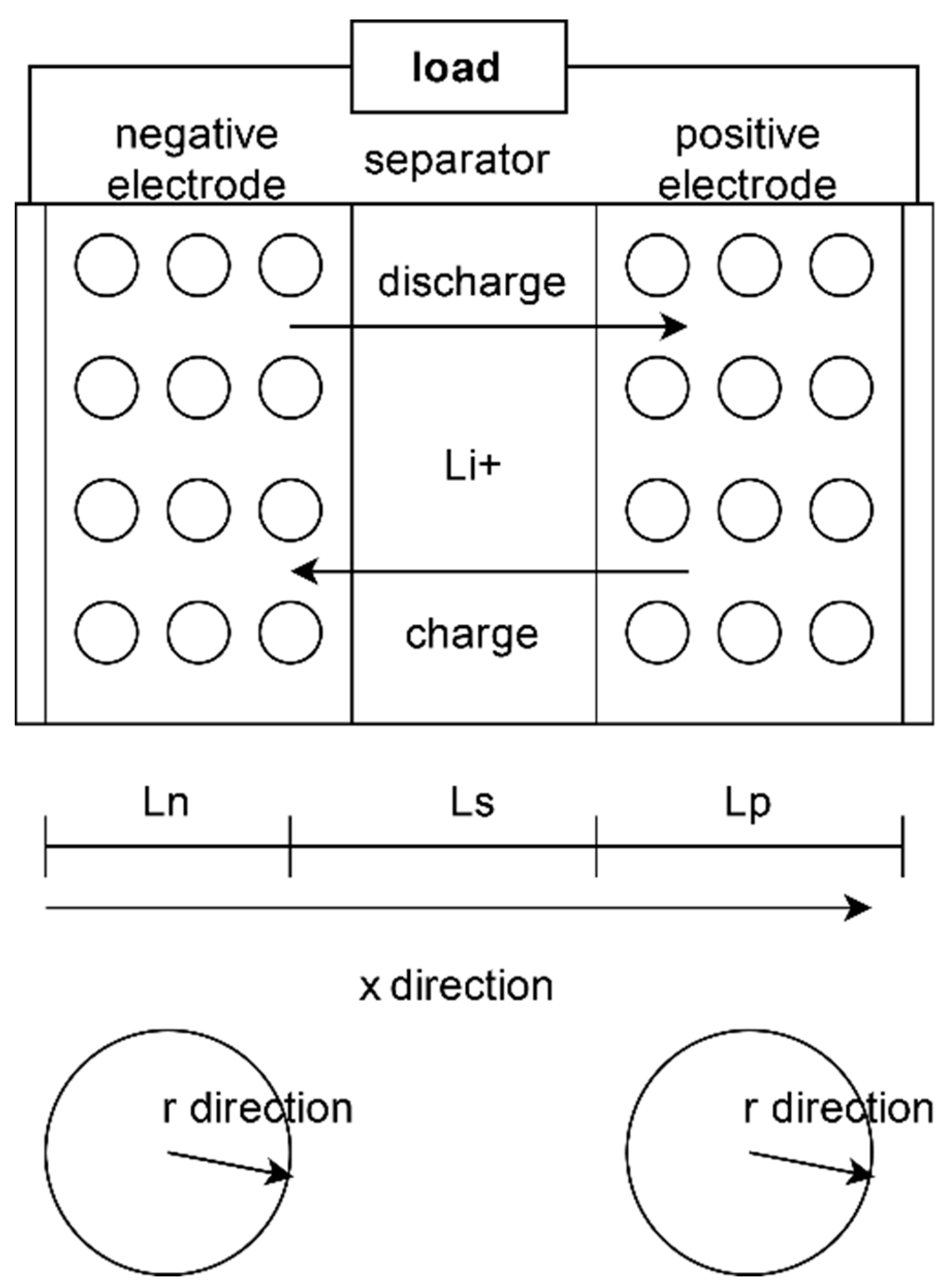

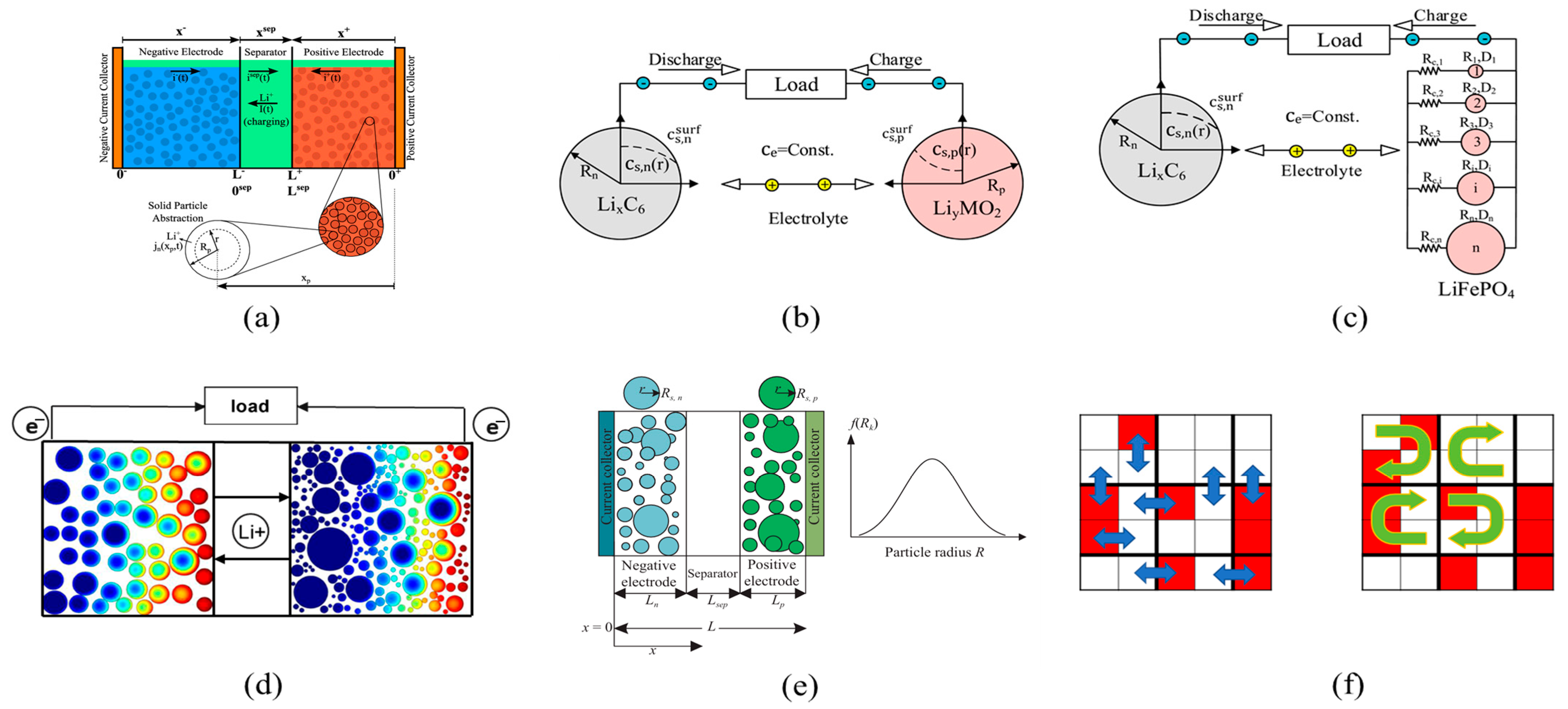
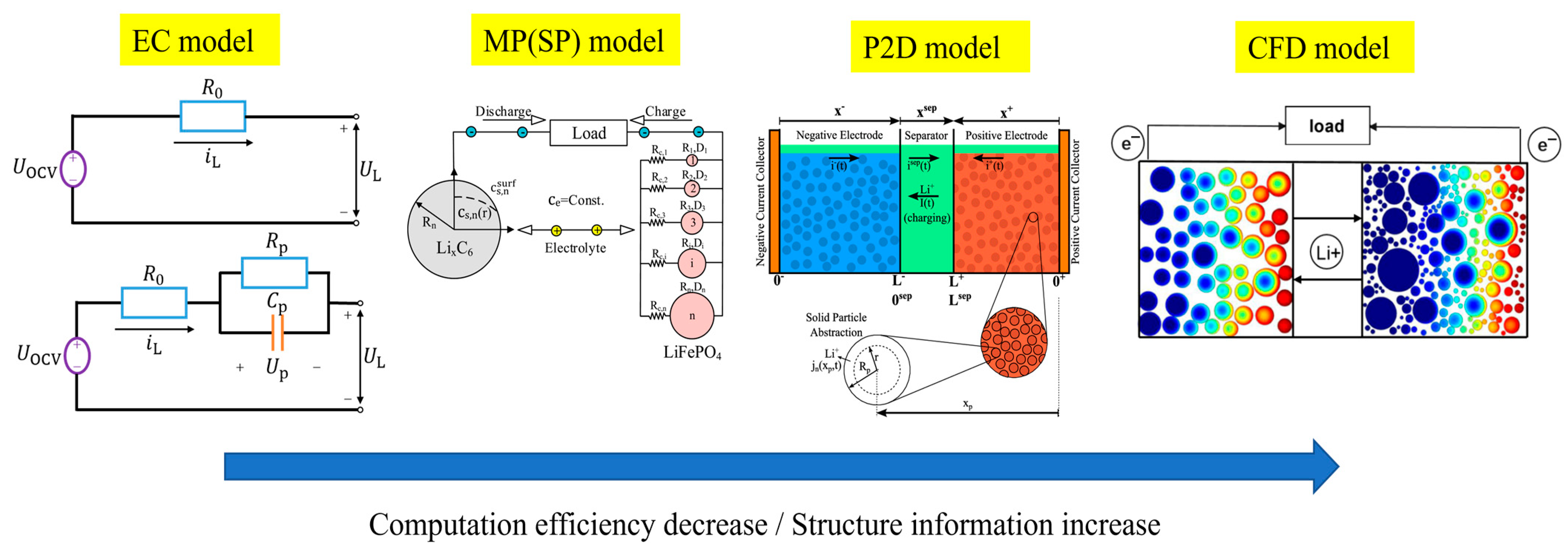
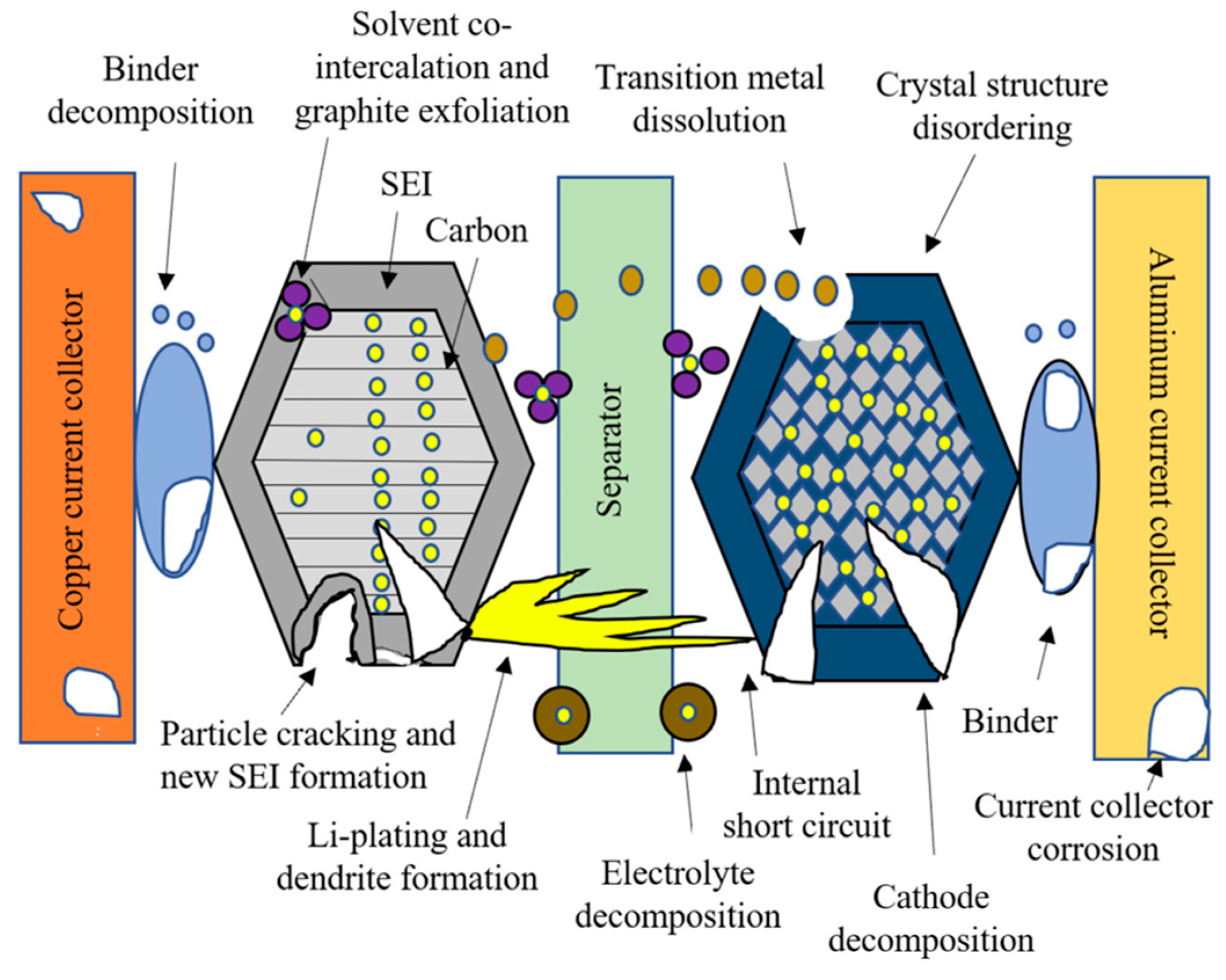
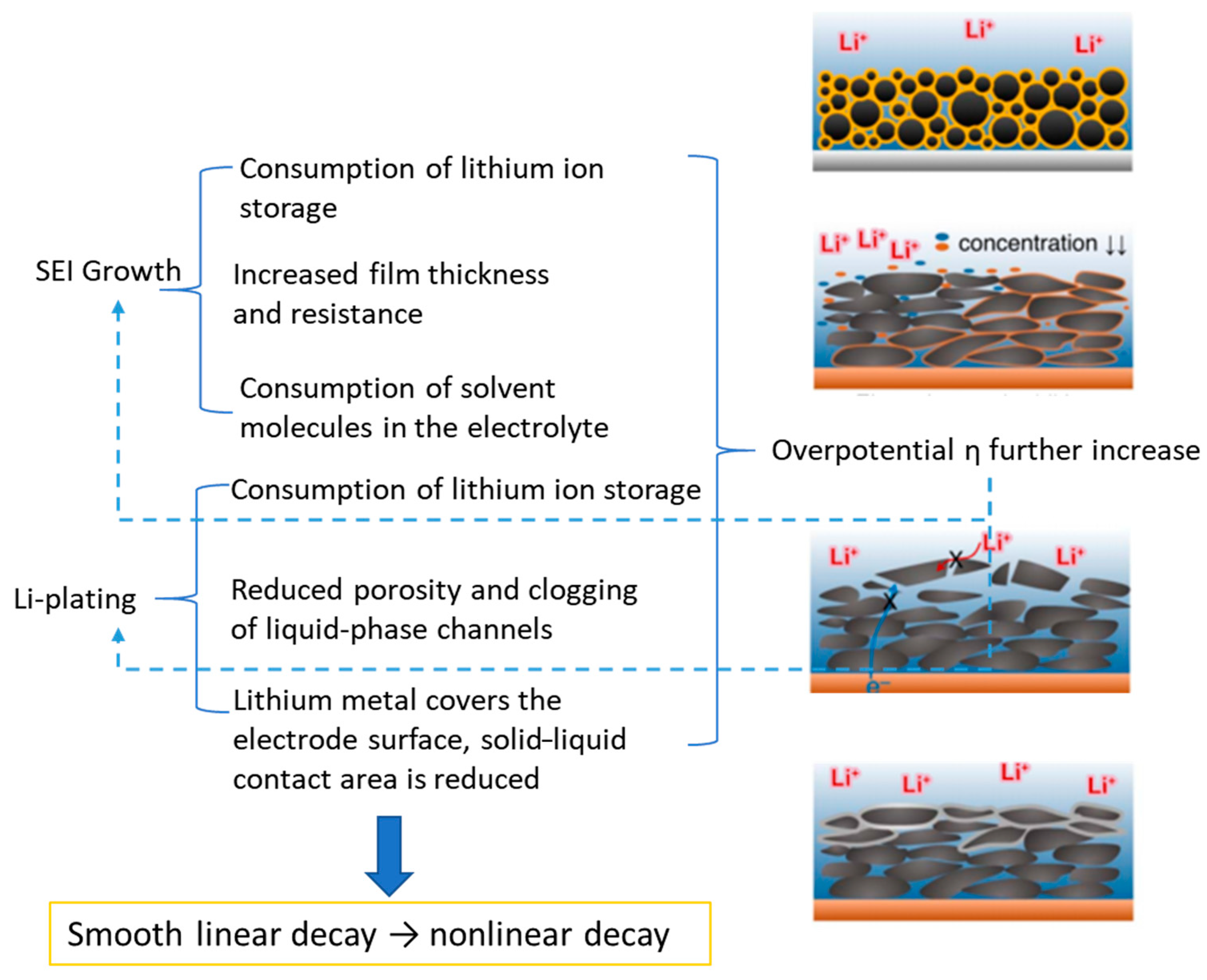
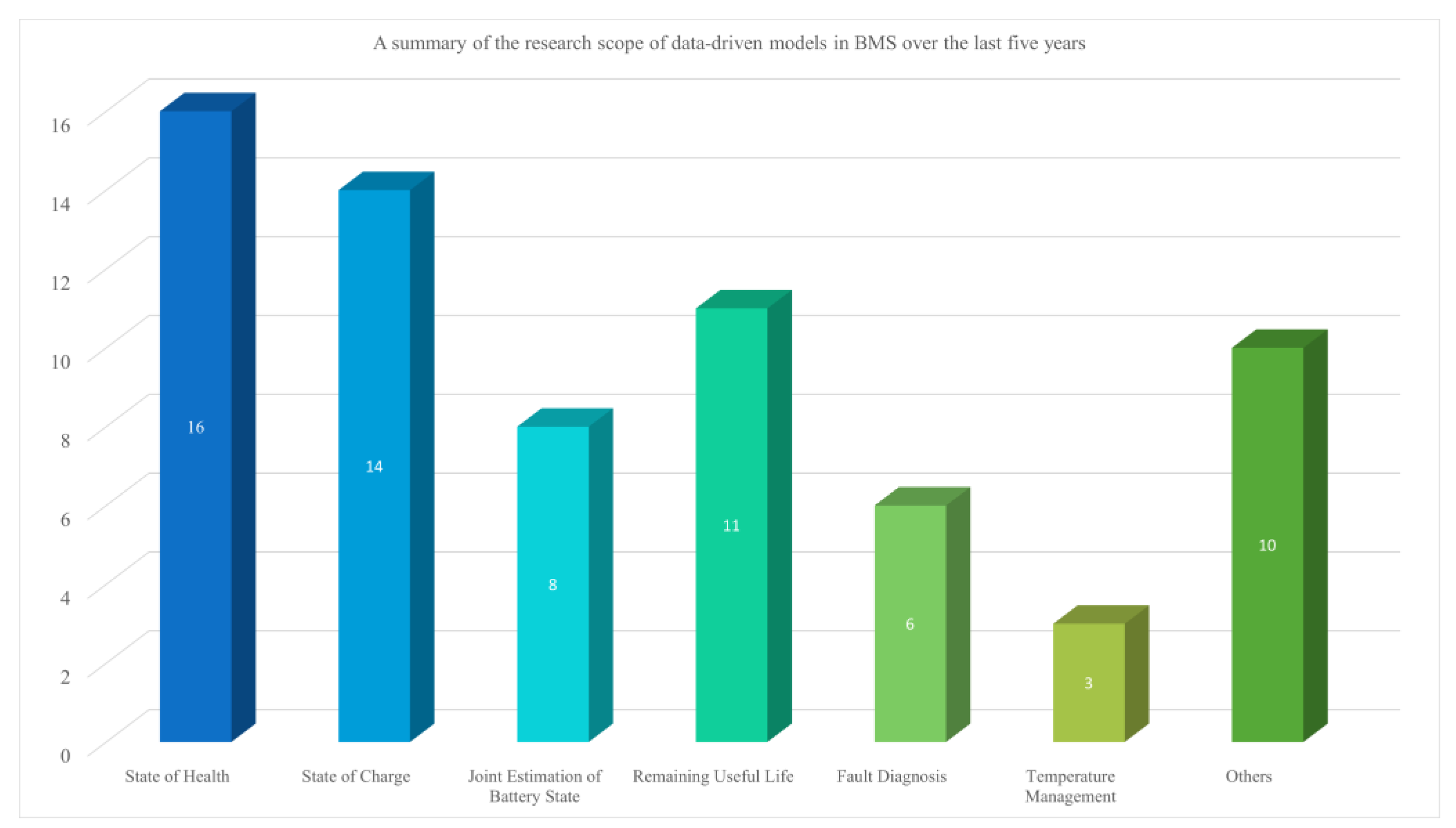




| Types | Schematic | State Equation |
|---|---|---|
| The Rint model | 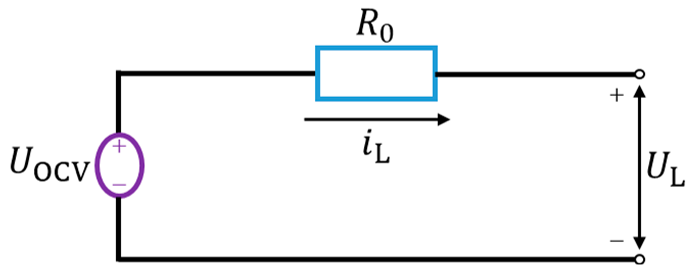 | |
| The Thevenin model | 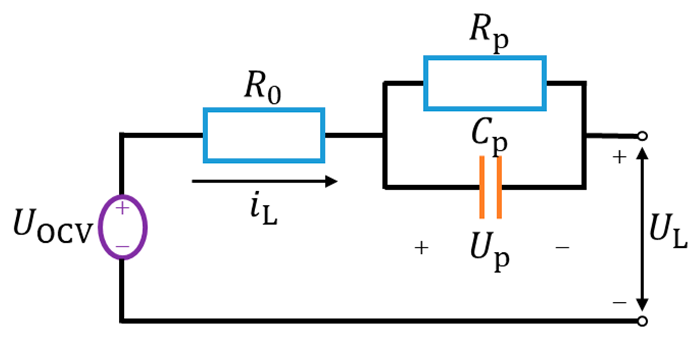 | |
| The second-order RC model |  | |
| The PNGV model | 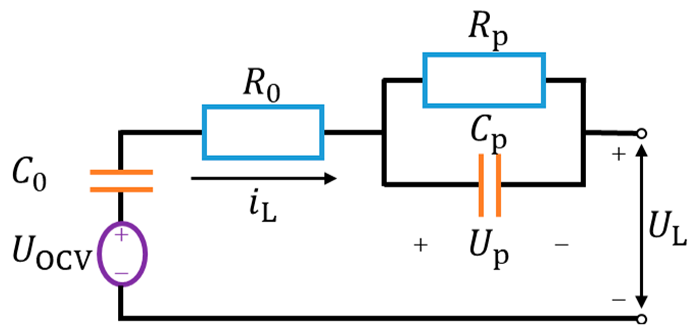 | |
| The GNL model | 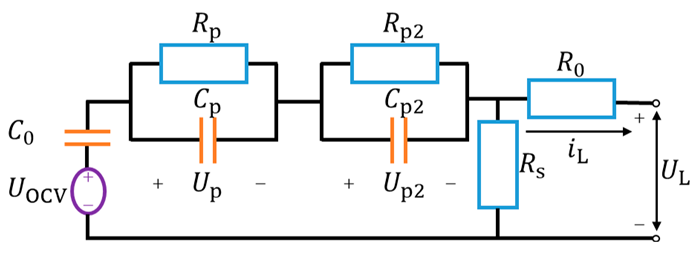 |
| Model | Overview | Strength | Limitation |
|---|---|---|---|
| P2D | Under the assumption of the uniform distribution of spherical particles, the liquid-phase variables are calculated along the x direction, while the solid-phase variables are calculated along the r direction. | It is capable of considering the influence of porosity and particle size, while maintaining a moderate calculation efficiency. | It cannot consider the non-uniform distribution and irregular nature of particles, and the calculation speed may not satisfy the requirements for electrode structure optimization and online applications. |
| SPM | The cathode and anode in the P2D model are simplified to a single spherical particle. | It has the highest computational efficiency among electrochemical models. | The computational accuracy decreases significantly under high-current charging and discharging conditions, and it fails to consider the influence of porosity. |
| MPM | It is equivalent to the coupling of multiple SPMs, in which both the cathode and anode are considered to be composed of particles of various sizes. | Featuring moderate computational efficiency, it also incorporates a degree of consideration for the distribution information of electrode particles. | The influences of porosity and particle position distribution cannot be considered. |
| PSD | A further improvement of the MPM, in which the influence of particle-size distribution on battery operational mechanisms is incorporated. | The PSD model is capable of considering various particle-size distributions, enabling a more detailed investigation into the influence of electrode particle sizes on battery performance. | The influence of particle position distribution cannot be considered. |
| CFD | Considering mass transfer and reaction processes in electrodes with arbitrary morphologies. | It enables the visualization of the spatio-temporal evolution of variables, and the construction and evaluation of electrodes with arbitrary shapes and morphologies. | The computational efficiency is generally low. |
| MSMD | Interacting with the averaged values of variables across different scales to achieve multi-scale modeling. | By correlating the particle scale, electrode scale, and battery scale, it enables the exploration of the interaction mechanisms among variables across different scales. | Using only averages for interaction enhances computational efficiency but results in the loss of spatial distribution information. |
| CA-FD | A hybrid approach for LIB modeling, in which CA is adopted to describe reaction–diffusion processes and FD methods are used to calculate potential distributions | Capable of considering electrodes with arbitrary morphologies and featuring a high computational efficiency. | The selection of time steps for the two parts of the model requires exploration to find a matching time step that maintains the rationality and accuracy of the step-by-step calculations. |
| Encoding | Charging Strategy | Channel | Cycle Life |
|---|---|---|---|
| EL150800460623 | 3.6C(80%) −3.6C | 3 | 1177 |
| EL150800464977 | 4.0C(80%) −4.0C | 5 | 1226 |
| EL150800464883 | 4.4C(80%) −4.4C | 7 | 1074 |
| EL150800465027 | 4.8C(80%) −4.8C | 9 | 870 |
| EL150800464002 | 5.4C(80%) −5.4C | 11 | 534 |
| No. | Name | Encoding |
|---|---|---|
| 1 | BatteryAgingARC-FY08Q4 | B0005–B0007, B0018 |
| 2 | BatteryAgingARC_25_26_27_28_P1 | B0025–B0028 |
| 3 | BatteryAgingARC_25-44 | B0025–B0034, B0036, B0038–B0044 |
| 4 | BatteryAgingARC_45_46_47_48 | B0045–B0048 |
| 5 | BatteryAgingARC_49_50_51_52 | B0049–B0052 |
| 6 | BatteryAgingARC_53_54_55_56 | B0053–B0056 |
Disclaimer/Publisher’s Note: The statements, opinions and data contained in all publications are solely those of the individual author(s) and contributor(s) and not of MDPI and/or the editor(s). MDPI and/or the editor(s) disclaim responsibility for any injury to people or property resulting from any ideas, methods, instructions or products referred to in the content. |
© 2024 by the authors. Licensee MDPI, Basel, Switzerland. This article is an open access article distributed under the terms and conditions of the Creative Commons Attribution (CC BY) license (https://creativecommons.org/licenses/by/4.0/).
Share and Cite
Ji, C.; Dai, J.; Zhai, C.; Wang, J.; Tian, Y.; Sun, W. A Review on Lithium-Ion Battery Modeling from Mechanism-Based and Data-Driven Perspectives. Processes 2024, 12, 1871. https://doi.org/10.3390/pr12091871
Ji C, Dai J, Zhai C, Wang J, Tian Y, Sun W. A Review on Lithium-Ion Battery Modeling from Mechanism-Based and Data-Driven Perspectives. Processes. 2024; 12(9):1871. https://doi.org/10.3390/pr12091871
Chicago/Turabian StyleJi, Cheng, Jindong Dai, Chi Zhai, Jingde Wang, Yuhe Tian, and Wei Sun. 2024. "A Review on Lithium-Ion Battery Modeling from Mechanism-Based and Data-Driven Perspectives" Processes 12, no. 9: 1871. https://doi.org/10.3390/pr12091871
APA StyleJi, C., Dai, J., Zhai, C., Wang, J., Tian, Y., & Sun, W. (2024). A Review on Lithium-Ion Battery Modeling from Mechanism-Based and Data-Driven Perspectives. Processes, 12(9), 1871. https://doi.org/10.3390/pr12091871










